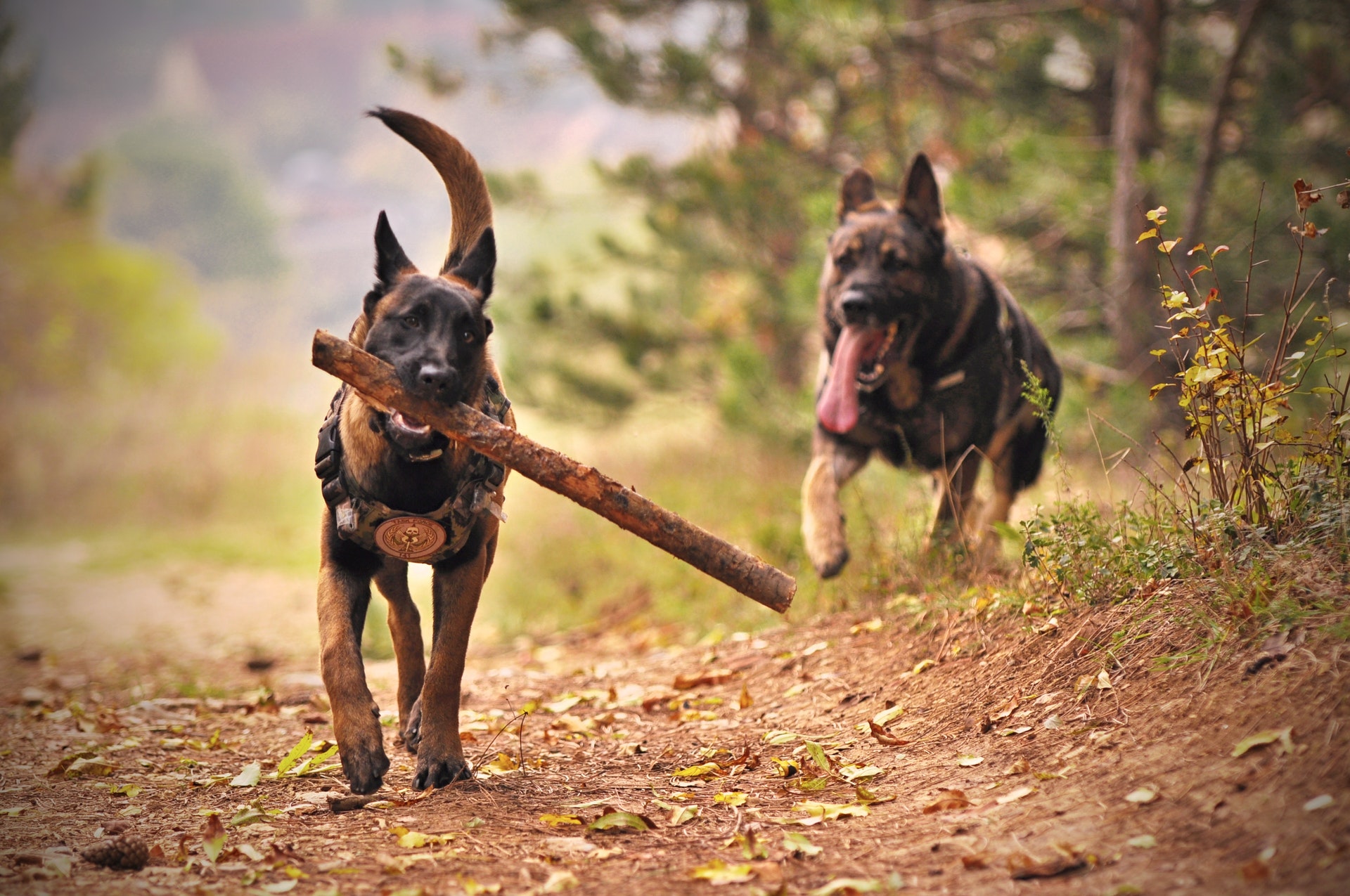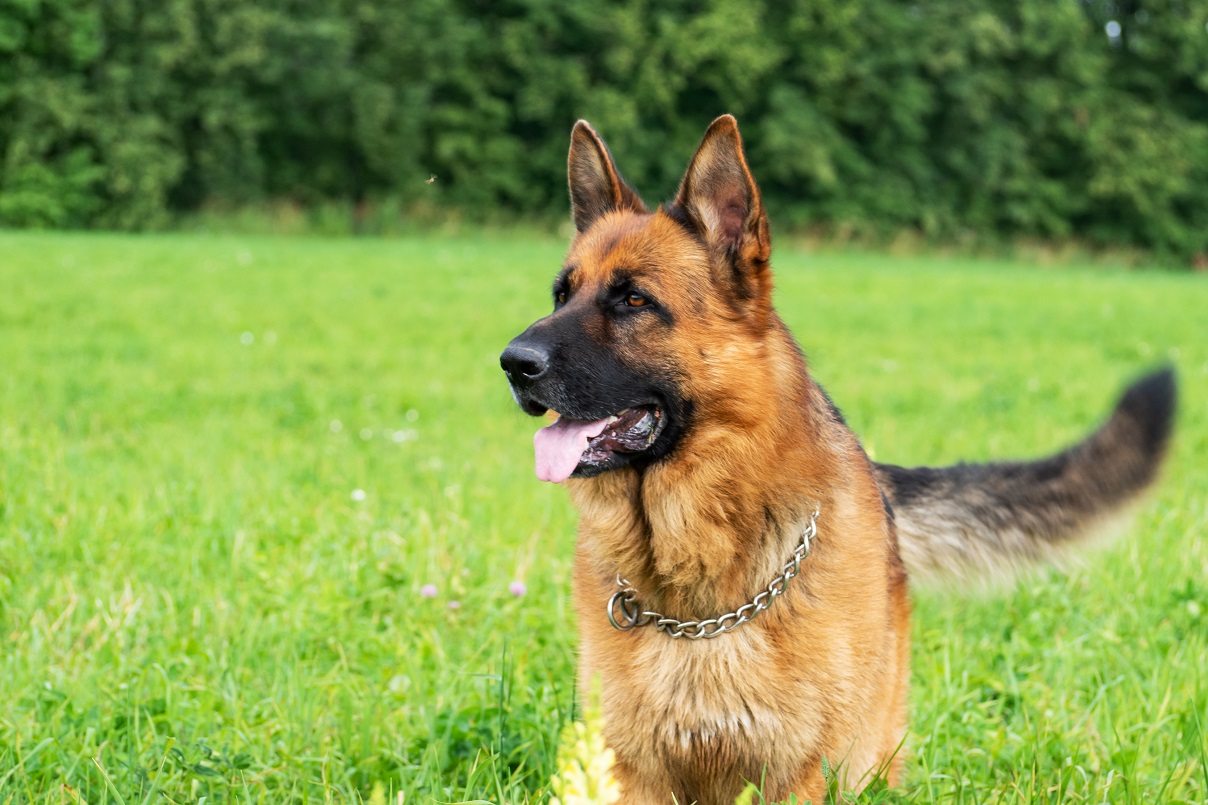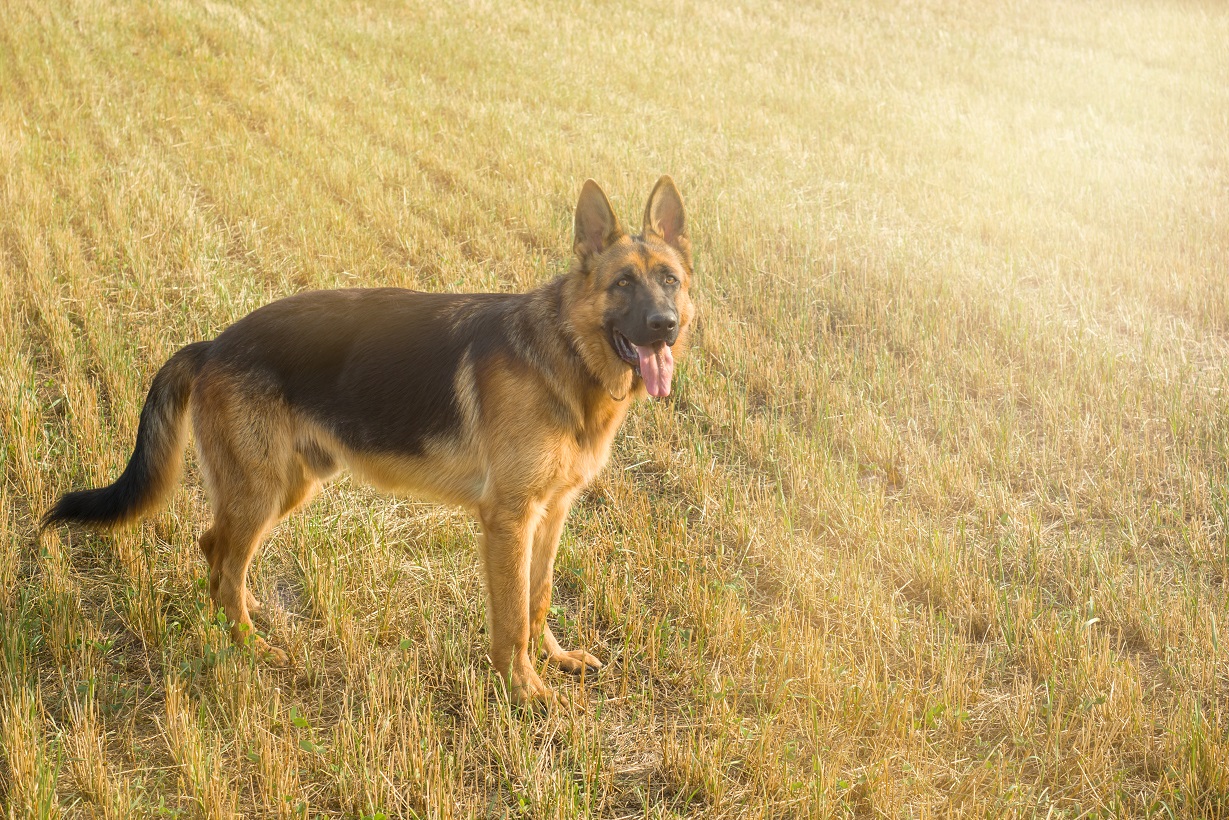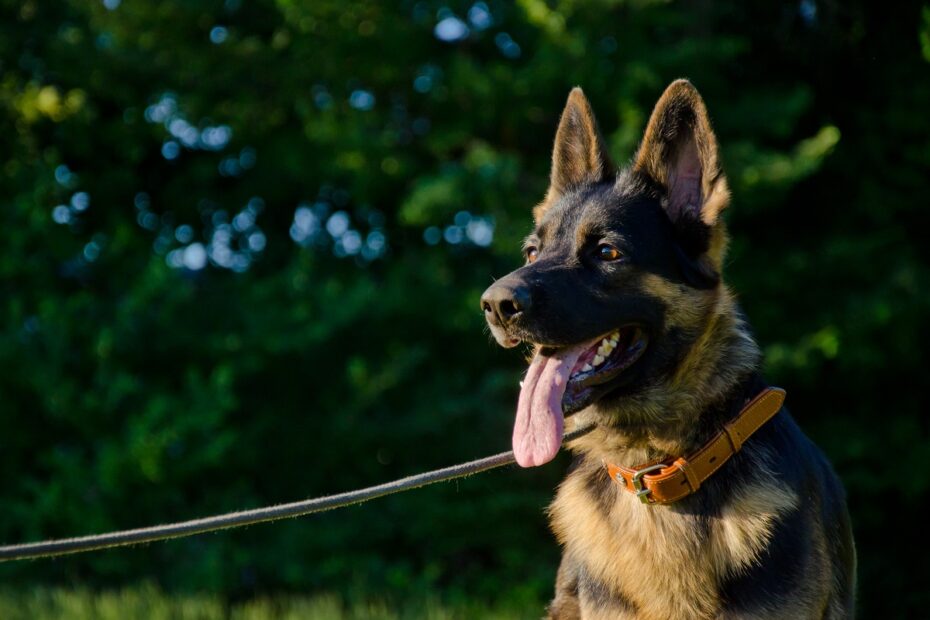Leash training a German Shepherd can be a fun, rewarding experience.
Why?
Because German Shepherds are smart. When brains were being handed out, German Shepherds were at the front of the line.
Eager to learn and capable of retaining vast amounts of information, your German Shepherd will absorb, process, and hang on to your every word.
But don’t think this gives you an excuse to slack off on your duties. Just because a dog is smart doesn’t mean they have an innate understanding of what to do in every given situation.
If you want your dog to walk politely on the leash, you’ll need to put the effort in. With time, patience, and training, a German Shepherd will usually adapt to the leash easily.
But with a slapdash or hurried approach, they won’t. And that’s a problem.
See, your German Shepherd might be a cute little ball of fluff now, but before long, they’ll be 85lbs of lean muscle.
And if there’s one thing no other dog or dog owner wants, it’s 85lb of lean muscle barreling up to them when they’re out and about.
By introducing some leash manners to your dog now, you’ll be able to maintain control over them as they grow into adults. Something that’s vital for them, for you, and for every other critter and creature you come across.
And the key to the process is ensuring your dog is calm, controlled, and ready to listen.
So before you launch into training, take a few minutes to check out these 5 step-by-step calming exercises from Dan Abdelnoor over at The Online Dog Trainer. (see video below)
Used consistently, they’ll help transform even the most excitable dog into a model student.
(video will open in a new window)
Leash Training a German Shepherd vs Other Dog Breeds
The German Shepherd is an amazing breed. They’re confident, affectionate to a fault, and a dream to train.
More than anything else, German Shepherds are loyal. If you want a dog that’s going to stick by your side no matter what, the German Shepherd is the one for you.
Whereas many other breeds are escape artists, you don’t have to worry about your German Shepherd making a bid for freedom. Show them an escape tunnel, and they’ll wait patiently until you lead the way.
But there’s a flip side to everything. While loyalty is admirable, desirable, and all kinds of wonderful, it comes with its problems.
Your German Shepherd’s unfailing devotion can translate to extreme protectiveness, a trait that puts them on constant alert.
It’s not unusual for a German Shepherd to spend all day barking at a window or patrolling a yard to keep their family safe.
Neither is it unusual for them to become so attached to their owner; they can’t bear to be apart from them.
Separation anxiety is a real problem for many German Shepherds. Long hours alone will leave your dog unhappy, anxious, and very possibly destructive.
And then there’s the aggression to consider. Because German Shepherds are aggressive, right?
Wrong.
Sure, German Shepherds who’ve been badly trained or mistreated can become aggressive. As can every other breed in the world.
And there’s the rub. Any dog, regardless of breed, can be prone to undesirable or anti-social behaviors if it’s not given the proper guidance.
Alert barking and territorialism a problem? …Then let your German Shepherd know that you’re the alpha and perfectly capable of looking after them, yourself, and your family.
Worried about separation anxiety? …Look into conditioning techniques.
Concerned about breed-specific aggression? …Take preventative measures with early socialization and proper training.
A German Shepherd IS different from certain other breeds.
Their loyalty and protective tendencies are off the charts. But that doesn’t mean their needs are fundamentally different from any other dog.
Positive training techniques, early socialization, and consistency are what all dogs need, and the German Shepherd is no different.
Training really will do wonders for your German Shepherd.
It’ll build their confidence, stimulate their little gray cells, stretch their intelligence, prevent boredom, and familiarize them with how to behave around other dogs and people.
Even better, the German Shepherd is a joy to train. They’re sharp as a tack, eager to impress, and capable of learning up to 200 words.
Just remember that your dog isn’t responsible for training themselves. That’s your job. If you go into the process in a half-hearted way, you can’t expect your dog to flourish.
When it comes to training a German Shepherd, remember…
- Consistency is key
- Stay calm, confident, and authoritative.
- Keep your patience: the moment you lose your patience is the moment you lose respect.
- Training never stops: reward all good behavior, whether it’s during a training session or not.
Related Post: The Ultimate Guide To German Shepherd Obedience Training

Common Problems You Might Face When Leash Training Your GSD
Some dogs adapt quickly and easily to the leash. A bit of positive encouragement, and they’ll soon be trotting by your side comfortably.
But for every dog that loves the leash, there’s another that sees it as the enemy.
Before you immerse yourself in training, it pays to be aware of some of the common problems you might run into. Problems like…
Pulling on the Leash
Rather than give in to pressure, some dogs will pull against it.
They don’t necessarily understand that you’re on the other side of the leash. The only thing they’re interested in is what’s in front of them.
And the one thing they want to do is get there as soon as possible.
It doesn’t take a dog long to learn that when they pull, they get where they want to go much faster.
For some dogs, the urge to pull only kicks in at the beginning of a walk or when they spot something exciting.
For others, it’s a normal way of walking.
Mouthing and Chewing the Leash
Some dogs are orally fixated. If they don’t have something to chew or carry in their mouths 24/7, they get grumpy.
For many dogs like this, chewing or biting on the leash is a calming activity. For others, it’s a way of getting attention. Some just see it as a game.
Some dogs like to confine mouthing or chewing the leash to the start of a walk, while others like to continue it for the duration.
Either way, it’s a habit that can get annoying fast.
Reacting on the Leash
Leash reactivity is a common complaint.
If a leash reactive dog sees another dog, a jogger, a skateboarder, or some other innocent passerby. They might lunge, bark, and pull at the leash.
In most cases, the behavior is caused by anxiety and frustration.
Some dogs want to get to the stimulus and get frustrated when the leash stops them. Other times, they become frightened and desperate to get away.
In cases like this, punishment and scolding only serve to exacerbate the problem.
Leash Refusal
Some dogs refuse point blank to have anything to do with a leash.
If they’re a puppy or a rescue dog, their leash-refusal might be down to unfamiliarity. If they’re not used to it, the pressure of a leash on their neck can be uncomfortable.
Trying to coax them to walk by pulling on the leash can trigger their opposition reflex and make them slam on the brakes even harder.
If a dog finds walks overstimulating or stressful, they might eventually decide it’s not worth the bother and cower and hide whenever your approach them with the leash.
Related Post: What To Do If Your Dog Pulls On The Leash And You’ve Tried Everything

The Best Way to Leash Train a German Shepherd
German Shepherds are one of the most intelligent breeds around. But no matter how smart a dog is, they won’t know how to walk on a leash until you train them.
Although you can leash train a dog at any age, the younger the dog is when you start, the easier it’ll be.
Before you begin, remember one key thing. An excited, overstimulated dog isn’t going to sit quietly by and soak up your instructions.
Take some time before each training session or walk to put your pooch into a calm, focused mindset with these 5 step-by-step calming exercises.
Once your dog is calm and ready to learn, it’s time to start.
Keep Introductions Fun
Don’t expect to slip a leash on your dog and head straight to the park.
If your German Shepherd is new to the leash, let them wear it around the house first. Stick around to supervise in case it gets caught or tangled.
While they’re getting used to the new sensation, reward them with plenty of treats and games. The more fun they have wearing the leash, the better the associations they’ll form with it.
Teach Them a Cue
Once your dog has got used to the sensation of the leash, you can move to the next stage.
Teach them a cue word or a sound that encourages them to come to you. This can be as simple as a cluck of the tongue or the word ‘yes.’
When you’re in a quiet space that’s free of distractions, put the leash on and use the cue. As soon as they turn to look at you or start to approach you, reward them with a treat.
Once they’re approaching you each time you issue the cue, start taking a few paces back.
Reward them when they follow you. Keep practicing until your dog is walking a few paces with you each time.
Related Post: 4 Simple Steps To Leash Training An Older Dog

Take the Fun Outside
Once your dog is happily keeping pace with you when you issue a cue, it’s time to take the fun outside.
With so many intriguing sights and sounds around, your pup might get distracted. To keep them on track, keep the walks short and sweet at first.
If they pull on the leash or get distracted, use the same cue sound you used in your earlier training to refocus their attention on you.
Be Patient
Adjusting to the leash takes time. Stay patient and let your dog acclimatize to it at their own pace.
If they look nervous, pet them and reassure them. Keep a bag of treats with you to reward good behavior.
The more fun you have, the quicker your dog will learn to enjoy leashed walks.
Create Some Calm
For some dogs, just the sight of the leash is enough to turn them into a lather of excitement.
If your pup starts lunging, barking, or spinning around in circles the moment you take the leash out, wait for them to calm down before you put it on.
Before each walk, spend a few minutes running through these 5 step-by-step calming exercises. They’ll go a long way to fostering the calm environment you need.
Invest in a Comfortable Leash
Some dog owners make the mistake of thinking only heavy-duty leashes and harnesses are sufficient to keep their dog safe.
In reality, heavy, bulky equipment does little more than make your dog uncomfortable. Look instead for the lightest equipment that’s suitable for your dog’s size.
If your dog pulls on the leash when they’re excited, avoid retractable leashes and stick to a fixed-length one instead.
Summing Up
As the lucky owner of a German Shepherd, you have the advantage of working with a highly intelligent, easy-to-train breed that loves to please. But that’s not an excuse to let standards slip.
Regardless of breed, leash training requires patience, consistency, and more than a little work. Is it worth the effort? Absolutely.

